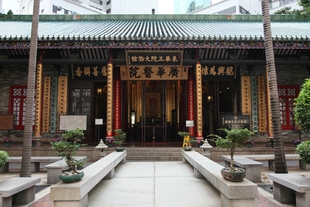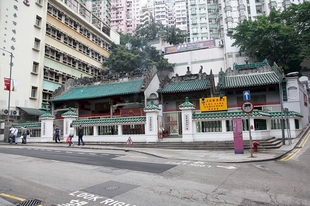Man Mo Temple and Tung Wah Museum declared monuments
The Government announced that the Antiquities Authority declared the Tung Wah Museum at Kwong Wah Hospital in Yau Ma Tei and the Man Mo Temple Compound in Sheung Wan as monuments under the Antiquities and Monuments Ordinance on 12 November. The notice of the declaration is gazetted on the same day.
The Tung Wah Museum on Waterloo Road was originally the Main Hall of Kwong Wah Hospital. The founding of Kwong Wah Hospital was initiated by the directors of the Tung Wah Hospital and the community leaders of Kowloon. Opened in 1911, Kwong Wah Hospital was the first hospital founded in Kowloon and had been providing both Western and Chinese medical services to the community since then. In 1931, Tung Wah Hospital, Kwong Wah Hospital and Tung Wah Eastern Hospital were amalgamated into a single entity, “Tung Wah Group of Hospitals” (TWGHs). In 1970, the centenary year of TWGHs, the Main Hall of Kwong Wah Hospital was converted into the Tung Wah Museum for conserving the relics and the invaluable archives of the TWGHs. The Museum was subsequently open to the public in 1993.
The museum building is of Chinese Renaissance style characterized by a composition of Chinese and Western architectural features. Its Chinese style is clearly demonstrated by the setting of a Chinese ancestral hall and the decorations at the front elevation, whereas Western architectural elements are displayed through the bull’s eye windows and segmental arched windows on the sides and rear elevation, as well as the Western fanlights and Queen post trusses inside the museum.
The Man Mo Temple Compound on Hollywood Road was built approximately between 1847 and 1862 by wealthy Chinese merchants. The Temple has imperative historical and cultural values to the territory, representing the social organization and religious practices of the Chinese community in old Hong Kong. The main hall of the Man Mo Temple was built for the worship of the God of Literature and the God of Marital Arts; the Lit Shing Kung adjacent to the main hall was built for the worship of all heavenly gods and Kung Sor was constructed as a meeting place for resolving matters related to the Chinese community in the area. The Temple was officially entrusted to the Tung Wah Hospital with the enactment of the Man Mo Temple Ordinance in 1908. Directors of TWGHs and community celebrities congregate in the Temple every year for the Autumn Sacrificial Rites to pay homage to the God of Literature and the God of Marital Arts as well as to pray for the prosperity of Hong Kong.
The magnificent Temple is a typical example of traditional Chinese vernacular architecture. It is exquisitely decorated with ceramic figurines, granite and wood carvings, plastered mouldings and murals, reflecting superb traditional craftsmanship
The two declared monuments are open for public visit. Free guided tours will be provided later for the public to enhance their understanding of the monument buildings and the related local history.
Information on the monuments is available on the heritage conservation website of the Development Bureau (http://www.heritage.gov.hk/).
About TWGHs
Established in 1870, Tung Wah Group of Hospitals has been all along upholding its mission “To heal the sick and to relieve the distressed; to care for the elderly and to rehabilitate the disabled; to promote education and to nurture youngsters; and to raise the infants and to guide the children.” Nowadays, Tung Wah has become the largest charitable organization in Hong Kong. For over a hundred years, Tung Wah’s medical and health, education and community services have developed rapidly to fulfill the needs of the society and to provide high quality services at low rates. Today, Tung Wah operates 223 services centres, including 5 hospitals, 19 Chinese and Western medicine treatment and health management centres; 50 schools and 148 community services centres, to provide a spectrum of social welfare services catering to the needs of families, children and youth, the elderly and the disabled. In addition, Tung Wah Museum aims to facilitate the protection of cultural heritage work by promoting the history of the group and restoration and preservation of institutional archives.
* End *
For media enquiries, please contact Ms. Ivy LAU, Principal Corporate Communications Manager, at 2859 7853.

The Tung Wah Museum at Kwong Wah Hospital in Yau Ma Tei is in the Chinese Renaissance style, characterized by a composition of Chinese and Western architectural features.

The Man Mo Temple Compound in Sheung Wan is a typical example of traditional Chinese vernacular architecture. It is exquisitely decorated with ceramic figurines, granite and wood carvings, plastered mouldings and murals, reflecting superb traditional craftsmanship.



